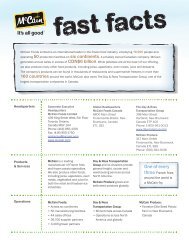From the Ground Up - McCain Foods Limited
From the Ground Up - McCain Foods Limited
From the Ground Up - McCain Foods Limited
Create successful ePaper yourself
Turn your PDF publications into a flip-book with our unique Google optimized e-Paper software.
LEFT: Harrison and Wallace<br />
at <strong>the</strong> site of <strong>the</strong> Florenceville<br />
factory, 1956.<br />
RIGHT: Opening ceremony,<br />
February 23, 1957. Wallace<br />
<strong>McCain</strong> (far left) watches on<br />
as New Brunswick premier<br />
Hugh John Flemming (far<br />
right) and Milton Gregg,<br />
federal minister of labour,<br />
cut <strong>the</strong> ribbon.<br />
because <strong>the</strong> frozen food industry was still young, and its machinery and methodology<br />
were far from fully developed.<br />
While <strong>the</strong> factory was being built, Wallace and Harrison moved <strong>the</strong>ir young<br />
families from Saint John, a big city by New Brunswick standards, to <strong>the</strong> village of<br />
Florenceville, home to just a few hundred people. Wallace’s wife, Margaret (or Margie,<br />
as she is known), recalls <strong>the</strong> house she and her family moved into as small, cold,<br />
mouse-infested, and having a leaky roof. It was only later, once <strong>the</strong> company was successful,<br />
that <strong>the</strong> couple obtained a mortgage from <strong>the</strong> bank to build a better house,<br />
on a site overlooking <strong>the</strong> Saint John River. Wallace and Margaret hired an architect<br />
to design a $40,000 house, but Wallace couldn’t raise more than $30,000 from <strong>the</strong><br />
bank. He solved <strong>the</strong> problem by having <strong>the</strong> contractor “cut off ” a third of <strong>the</strong> rooms,<br />
at <strong>the</strong> back of <strong>the</strong> house.<br />
Harrison and Marion (Billie) <strong>McCain</strong> built a house next door to Wallace and<br />
Margie. Both houses were enlarged in later years, though <strong>the</strong> original fronts remain<br />
in place.<br />
The official opening of <strong>the</strong> <strong>McCain</strong> <strong>Foods</strong> factory was a major event, not just for<br />
Carleton County but for all of New Brunswick. Premier Hugh John Flemming cut <strong>the</strong><br />
ribbon for <strong>the</strong> factory and Milton Gregg, <strong>the</strong> federal minister of labour, came from<br />
Ottawa to do <strong>the</strong> same for <strong>the</strong> cold storage unit. They were among <strong>the</strong> seven hundred<br />
people who crowded into <strong>the</strong> Florenceville high school for <strong>the</strong> opening ceremonies<br />
and speeches.<br />
Few of <strong>the</strong>m understood how big a challenge <strong>the</strong> <strong>McCain</strong> bro<strong>the</strong>rs had set for<br />
<strong>the</strong>mselves. Florenceville and its surroundings were farm country – not home to<br />
<strong>the</strong> skilled trades people needed to keep a large manufacturing operation going.<br />
Wallace <strong>McCain</strong> recalls going to garages looking for mechanics who would be able<br />
to maintain <strong>the</strong> equipment in <strong>the</strong> new factory. “No one knew anything about <strong>the</strong><br />
technical part of <strong>the</strong> business,” he says. “There were no machines like that around<br />
Florenceville.”<br />
Fortunately, Frank Hickling, who had assisted Olof Pierson in designing <strong>the</strong> plant<br />
and had been maintenance manager of <strong>the</strong> Birds Eye plant in Maine, stayed on as<br />
mechanic and plant manager. He had never finished high school, but he was smart<br />
and he knew how to run a frozen food factory. Nobody else did. “If we hadn’t had<br />
him, I don’t know what we would have done,” says Wallace. “Nobody else had any<br />
experience.”<br />
There was rarely a dull moment. The fryers sometimes overheated, causing <strong>the</strong> accumulated<br />
potato crumbs or oil filter paper to burst into flames. Wallace says he used<br />
to make sure he had his clo<strong>the</strong>s within easy reach when he went to bed in case he was<br />
called out to one of <strong>the</strong>se fires in <strong>the</strong> middle of <strong>the</strong> night. (Now all <strong>McCain</strong> plants use<br />
heat exchangers with high-pressure steam systems to heat <strong>the</strong> fryers. They also have<br />
flame extinguishing systems in <strong>the</strong> hood above <strong>the</strong> fryers, <strong>the</strong>reby eliminating <strong>the</strong><br />
risk of fires.)<br />
One of Pierson’s innovations was a machine that used steam to peel <strong>the</strong> skin off <strong>the</strong><br />
potatoes. It was shaped like an oil drum and had a door on <strong>the</strong> side through which<br />
<strong>the</strong> potatoes were loaded. The only problem was that sometimes <strong>the</strong> pressure of <strong>the</strong><br />
steam would blow <strong>the</strong> door off.<br />
10 <strong>From</strong> <strong>the</strong> <strong>Ground</strong> up<br />
t he BeG inninG 11<br />
LEFT: The trim table, 1957.<br />
This was “positive trimming,”<br />
in which each potato was<br />
individually trimmed.<br />
RIGHT: Opening-day tour:<br />
Wallace explains <strong>the</strong> packing<br />
area to Minister Gregg<br />
(centre), while Harrison chats<br />
with Premier Flemming.






